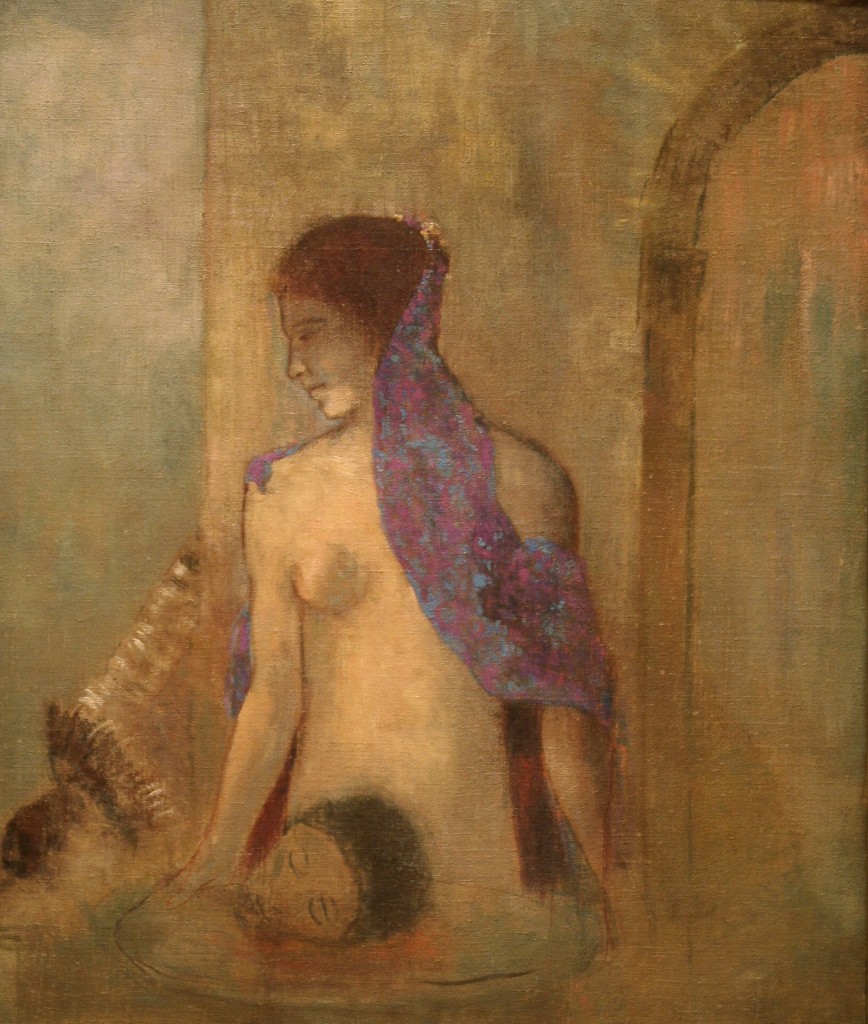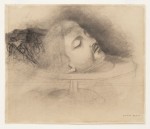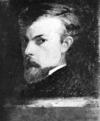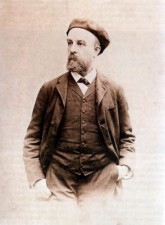

Odilon Redon
French, 1840-1916
Salomé, 1910
oil on canvas
28 1/4 x 23 in.
SBMA, Bequest of Wright S. Ludington
1993.1.6

Odilon Redon, self-portrait, 1904; in a private collection.
“A painter is not intellectual when having painted a nude woman, he leaves in our minds the idea that she is going to get dressed again right away.” - Odilon Redon
RESEARCH PAPER
Odilon Redon was born in Bordeaux in 1840 and raised by an elderly uncle on a family estate. His formal art education began at age fifteen. His first instructor was Stanislas Gorin, who encouraged Redon to draw from nature as well as imagination. Redon spent some time in Paris and studied with the strict academic painter Jean Louis Gerome. Returning to Bordeaux he functioned as a critic in the lively cultural scene, publishing reviews of works by Eugene Delacroix, Camille Corot, and Gustave Moreau. These artists exerted great influence on Redon. Rodolphe Bresdin. a painter and printmaker who created macabre landscapes, was a natural teacher and mentor for Redon. From Bresdin Redon learned etching and lithography. Bresdin and Moreau stood out against the surge of Naturalism in France during the 1860's and 1870's, and Redon echoed their footsteps.
Redon was nicknamed the "prince of the Dream" because the bulk of his work in the first twenty years of his career (1860's to early 1880's) consisted of black and white drawings in which his powerful exploitation of light and shadow, created a convincing world of mystery. Like Rembrandt, whose art he studied, Redon used chiaroscuro, the strong contrast of light and dark to impart subjective values. He noted, "Black should be respected. Nothing prostitutes it. It does not please the eye and does not awaken sensuality. It is the agent of the spirit much more than the splendid color of the palette or prism."
Yet, at the height of his reputation as "master of blacks". Redon began using radiant color harmonies that replaced the dominant black. Delacroix’ influence was evident in Redon's "phantasmagoric swirls of color blending the subjects of his earlier work with a new chromatic expression." Redon strove to have his drawings experienced like music, transporting the observer into the ambiguous world of the undetermined.
In Salomé, as in his other works, Redon suggests that the visible is not everything, that just beyond the seen is the hint or a mysterious unseen. Technically this is suggested by alernating “finished" and “unfinished” areas in his work therby rendering the objects ambiguous and elusive. The archetypal "femme fatale" was a popular subject in the Symbolists' work. Redon's Salomé synthesizes the sensuous and the spiritual, another tenet of the Symbolist Movement. Redon's mulatto wife figured in his work often and may well have been an inspiration here. Salomé appears before us quiet and pensive, not distraught or horrified over what she has done, what she holds in her hands. Her face is shadowed yet full light falls on her nude body, after all, this is what caused Herod to agree to the beheading of John the Baptist. Salomé holds a platter with John the Baptist's head showing hints of blood beneath it. The background is an unfinished area, in which the hints of some architecture are seen, but the overall effect of green, gray, blue. yellow and pink mottled together is vague. Salomé was more often the subject of Redon's friend Gustave Moreau. However, Moreau's Salomé differs greatly from Redon's. Moreau gives us the rich splendor of Herod's palace. Usually Moreau depicts Salomé in a finely jeweled and luxurious costume. Redon gives us a Salomé with a new interpretation: we know she is a classical "femme fatale", yet she appears here not as a seductress but rather innocent. It is her apparent modesty we see highlighted; what she is holding is really secondary and overall we are not horrified. In fact Redon shows us a Christian theme in a unconventional way. We do not have a leering King Herod and seductress but we have only a sweet girl embodying a Christian tenet: Honor thy father and thy mother. At this time Redon was also illustrating masterpieces of visionary and macabre literature but, as with our Salomé he never got consumed by the horror of the tales. Instead, he managed to distinguish, most effectively, between the traumatic and brutal impact of evil and the subtle evocation of a vague, alluring unknown. The decorative effect provided by the bright, variegated scarf framing Salomé associates Redon with the late 19th Century Post-Impressionist and Art Nouveau styles.
In this, as with all of Redon's art, what we are impressed with, what matters, is the intensely personal way he interprets his subjects. It is no mystery that Redon was continually surprised by his own art. As Maurice Denis, a Redon admirer, claimed "the lesson of Redon is his powerlessness to paint anything which is not representative of a state of soul, which does not express some depth of emotion, which does not translate an interior vision." In the Symbolist Movement, influential to the progressive painting at the end of the 19th Century in connecting Romanticism to 20th Century Surrealism, only Gaugin was more influential.
Prepared for the Docent Council by Barbara Lowenthal. May 1993.
BIBLIOGRAPHY:
Odilon Redon, The Phillips Collection, Washington DC, 1988.
Symbolist Art, Edward Lucie-Smith, Thames & Hudson, 1985.
Redon, Seurat and the Symbolists, Bloomsbury Books, 1970.
Odilon Redon, Acquavella Galleries, 1970.
Ian Woodner Collection, Jerusalem, 1985.
Grolier Electronic Publishing, Inc. 1992

Undated photo of Redon
